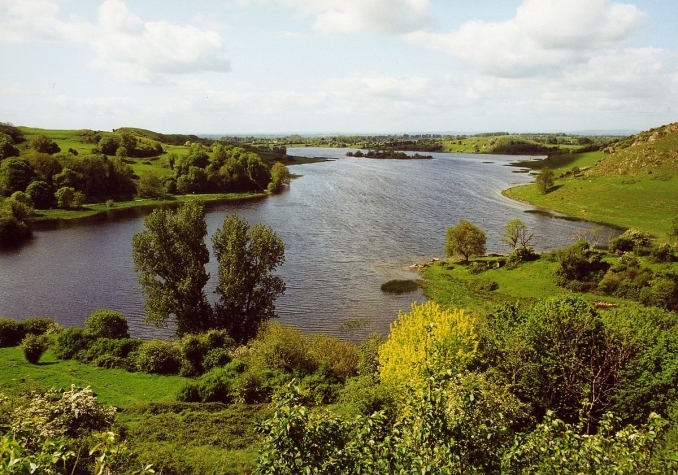Lough Gur - Loch Goir

Lough Gur (Irish: Loch Goir) is in County Limerick, Ireland (Irish: Contae Luimnigh, Éire). The lake is between the village of Herbertstown (Irish: Baile Hiobaird / Cathair Fuiseog) and the town of Bruff (Irish: An Brú). There are many megalithic sites at Lough Gur with evidence of human activity at least since about 3000 BC. The largest stone circle in Ireland, known as Grange stone circle, along with a dolmen are located close to the lake. There is a hillfort overlooking the lake, one of a number found in the area. The remains of a number of crannogs, which are artificial islands used as dwellings from the Neolithic period, have been discovered. Remains of houses dating to the Stone Age have also been found.
Lough Gur/Loch Goir Neolithic Settlement - Here are the remains of a Neolithic settlement which is located on the Knockadoon headland at the north of Lough Gur west of the R512 and southeast east of the R514 and west from Knockroe in County Limerick.
Lough Gur Wedge Tomb - It is a wedge shaped double walled tomb and possibly dating to the Bronze Age. This is located to the north of Lough Gur and close to Lough Gur Settlement.
Lough Gur Stone Circle/Grange Stone Circle - Grange Stone Circle is the largest in Ireland with the 113 stones in a diameter of 150 feet. The largest stone 'Ronnach Croim Duibh' weighing forty tons and over thirteen feet high. Around the stones is an earthen bank of about nine metres wide and about 1.2 metre in height. The alignment of the circle is set with the rising of the sun at the summer solstice. There is another stone circle to the north northeast of this circle and to the north of this is a standing stone. The site is located west of Lough Gur and off the Limerick-Kilmallock Road R512 north of Bruff. There is a Visitors Centre at Lough Gur with a website.
Lough Gur Legend of Legend poet Gearóid Iarla - Legend has is that Lough Cur is the place in which Earl of Desmond and poet Gearóid Iarla, is said to sleep in a cave. He was Gerald FitzMaurice FitzGerald (1335–1398) and in 1398 he mysteriously disappeared. Giving rise to the story of him asleep in a cave ready to emerge at a time of Ireland's need and gallop around the lake on a great white horse to reclaim his lands. In legend, Gearóid Iarla is also said to have had a romantic relationship with the Celtic goddess Áine, who is particularly strongly associated with County Limerick.
Link: Lough Gur Visitor Centre
Celtic nation:
- Ireland
Itinerary:
- Ireland Munster north
Place type:
- Ancient site





